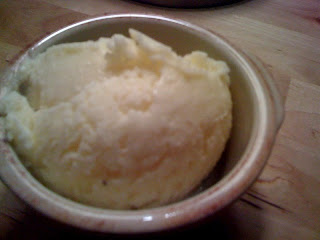The SAVEUR team had a big event with Telluride Ski Resort on Thursday night in the SAVEUR kitchen, featuring the cooking talents of the Telluride Executive Chef Stephen Roth.
One of the featured dishes was a rack of venison with spiced huckleberry Port sauce. It was delicious, but a little tough to eat at a cocktail party without knife and fork…so there was plenty leftover, and I went home with about 25 pieces of venison. However, unlike last time when I brought home the lamb, the meat was already cooked; I needed to figure out how to incorporate it into other dishes that I could eat or freeze to make sure the meat didn’t go to waste.
I added the meat back to the pan, along with the stock, some Worcestershire sauce, flour, and some herbs, then let everything simmer in the pan for about an hour and a half. In another pan, I covered some russet potatoes with salted water and brought it to a boil. Twenty minutes later, once strained, I added a splash of cream, a tablespoon of butter, and some salt & pepper, then set the mashed potatoes aside. When everything was ready, I assembled the crust-less “pie,” topping the meat with the mashed potatoes.
Once the potatoes turned a light golden brown number and the venison roux began to bubble, I removed the pie from the oven and let it cool briefly. Digging into the meal, we discovered that the nutmeg in the spice blend complemented the gaminess of the meat — and I even think I preferred this dish with venison rather than lamb. I served it with a side of spinach and a cheese biscuit to sop up the jus, and we sipped on the Clos de la Roilette 2009 Beaujolais from Fleurie, the same wine that had been paired with chef Roth’s rack of venison. Its complexity, with a bit of earthiness as well as bright fruit, was a refreshing contrast to the weight of the meal.
- 8 venison chops, cut into ½-inch cubes
- 2 leeks, white parts only, finely chopped
- 2 medium carrots, chopped
- 2 tbsp. flour
- 1 1⁄2 cups venison stock
- 1 tbsp. Lea & Perrins Worcestershire sauce
- 1 tbsp. finely chopped rosemary leaves
- 1 tbsp. finely chopped thyme leaves
- 1⁄8 tsp. freshly grated nutmeg
- Salt and freshly ground black pepper
- 3 medium russet potatoes, peeled and quartered
- Splash of Organic Valley half-and-half





